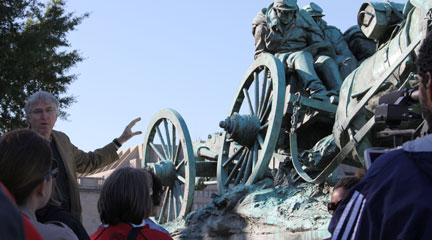At a Glance
Description
According to Christopher Hamner and Michael O'Malley, the Ulysses S. Grant Memorial in Washington, DC, presents a uniquely active look at the Civil War. As a work of art, the memorial draws the eye to Grant, standing above the chaos of surrounding battle, but it fails to include any reference to slavery as a cause of the war.
Ulysses S. Grant Memorial
Video Transcription
- Ulysses S. Grant Memorial
- Ulysses S. Grant Memorial
- 3:30
Christopher Hamner: Grant was fantastic and Mike has actually written a little bit on just why that is such an unusual piece of sculpture and it’s such a subtle piece of artwork and that if you look at it—if you don’t scrutinize it too closely it does look somewhat traditional and that it’s men on horseback and cannons and—
Michael O’Malley: Right you see it from a distance and you just start yawning before you even get close to it and you don’t even look and you go oh there’s a guy on a horse, wow, haven’t seen that before—
Christopher Hamner: You get close and you see that on one side it’s the beginning of a disaster. And I think more than the other two monuments that we visited, we looked at the Grant Memorial, not just as historians but also as a work of art. And it’s really very moving. And on the south side where it is sort of in the first moments of what looks like it’s going to be a horrific crash, just the sense of motion that is conveyed by this—
Michael O’Malley: Well so much—the guys on the back haven’t yet figured out what’s about to happen—
Christopher Hamner: You can see the tack on the horses going slack which tells you that this forward momentum has stopped but it has not yet gotten to the two guys who are riding the caisson—
Michael O’Malley: And they’re about to get jolted off or they’re about to fall off—
Christopher Hamner: And they’re sort of oblivious to what’s going on in the team and for something that’s frozen in metal the sense of power and emotion that’s not completely controlled, really came through to me.
Michael O’Malley: It’s a very powerful piece of art with a particular vision of war as grim endurance, not as discipline, triumph but as you know grim endurance against chaos—
Christopher Hamner: There’s heroism there, but it’s not the kind of heroism—
Michael O’Malley: It’s not the kind of heroism of the single mighty ideologue. Although maybe in Grant, right? Grant looks grimly ahead and if you read Grant’s memoirs he’s completely unflinching in his condemnation of slavery. He’s not some kind of flag-waving Garrisonian but you know it was a terrible cause, the worst cause men ever fought for.
Christopher Hamner: And they did a great job I thought at capturing Grant who was not McClellan, who did not show up in his battle finery—
Michael O’Malley: And peacock around—
Christopher Hamner: He’s there in a sort of—the kind of gear that he wore, his head’s down, he’s looking in the distance, shoulders are a little bit stooped. I mean you get the sense of the weight that’s been on the man and as you pointed out the two statues that are closer to ground level that involve the actual fighting troops are both focused on Grant—
Michael O’Malley: But he’s ignoring them.
Christopher Hamner: Much higher.
Michael O’Malley: He’s paying no attention. That’s not his problem. One of the students pointed out that Confederates are really present by their absence which is really interesting.
Christopher Hamner: It’s a great insight.
Michael O’Malley: They’re the cause of this chaos. They’ve just instigated these events which look to be pretty awful but they’re not actually shown. Which is very clever about it. It’s a very active monument. I think we both agree that the sad thing about it is it can’t get slavery. It can’t get the cause of the war. The war is a tragedy, but the political cause— You know there’s plenty of people that would say it’s not a tragedy, slavery is over. If your ancestors are slaves it’s not a tragedy at all, that’s great! Slavery isn’t depicted at all in the cause of the war so it depoliticizes it and that’s also the historical moment. You couldn’t do otherwise in America in 1913. It was the only political discourse available, I think.
 ,
, 
